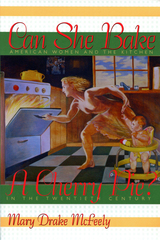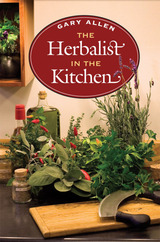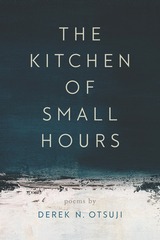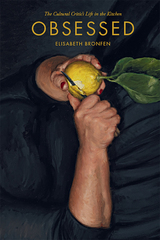7 books about Kitchen

Can She Bake a Cherry Pie?
American Women and the Kitchen in the Twentieth Century
Mary Drake McFeely
University of Massachusetts Press, 2001
In the rural America of the past, a woman's reputation was sometimes made by her cherry pie—or her chocolate layer cake, or her biscuits. As America modernized and as women left the home, entered the paid labor force, and battled their way to success in the professions, mastery of cooking remained an accepted sign that a woman took her gendered responsibilities seriously. Ironically, over the course of the twentieth century, as ready-made foods and kitchen appliances made home cooking less essential and labor-intensive, skill in the kitchen continued to be perceived not only by society but often by women themselves as a measure of a woman's true value.
This book shows how cooking developed and evolved during the twentieth century. From Fannie Farmer to Julia Child, new challenges arose to replace the old. Women found themselves still tied to the kitchen, but for different reasons and with the need to acquire new skills. Instead of simply providing sustenance for the family, they now had to master more complex cooking techniques, the knowledge of "ethnic" cuisines, the science of nutrition, the business of consumerism, and, perhaps most important of all, the art of keeping their husbands and children happy and healthy.
This book shows how cooking developed and evolved during the twentieth century. From Fannie Farmer to Julia Child, new challenges arose to replace the old. Women found themselves still tied to the kitchen, but for different reasons and with the need to acquire new skills. Instead of simply providing sustenance for the family, they now had to master more complex cooking techniques, the knowledge of "ethnic" cuisines, the science of nutrition, the business of consumerism, and, perhaps most important of all, the art of keeping their husbands and children happy and healthy.
[more]

A Domestic Cook Book
Containing a Careful Selection of Useful Receipts for the Kitchen
Malinda Russell
University of Michigan Press, 2025
A Domestic Cook Book (1866) by Malinda Russell is the oldest known published cookbook written by an African American woman. This new edition includes a foreword by scholar Rafia Zafar as well as an introduction by food historian Janice Bluestein Longone that contextualize Russell’s cookbook. Born in Tennessee and descended from Virginia freemen, Russell decided to move to Liberia at the age of 19. When her money for the trip was stolen, she ended up stranded in Lynchburg, Virginia, and began working as a cook and companion, traveling with ladies as a nurse. After living there for only four years, her husband died and she moved with her son to Tennessee where she kept a boarding house and then went on to run a pastry shop. After a second dramatic robbery in 1864, Malinda moved to Paw Paw, Michigan, because she had heard it was the “garden of the west” and published a cookbook “with the intention of benefiting the public” as well as supporting herself.
A Domestic Cook Book contains 260 recipes and household tips that draw from Malinda Russell’s twenty years of experience cooking in Southern kitchens, her boarding house, and her pastry shop, and showcase her skills as a pastry chef. Using the only known copy of the original book housed in the Janice Bluestein Longone Culinary Archive at the University of Michigan’s Clements Library, this new edition preserves an important part of Michigan and American history and makes it widely available to readers for the first time.
A Domestic Cook Book contains 260 recipes and household tips that draw from Malinda Russell’s twenty years of experience cooking in Southern kitchens, her boarding house, and her pastry shop, and showcase her skills as a pastry chef. Using the only known copy of the original book housed in the Janice Bluestein Longone Culinary Archive at the University of Michigan’s Clements Library, this new edition preserves an important part of Michigan and American history and makes it widely available to readers for the first time.
[more]

The Herbalist in the Kitchen
Gary Allen
University of Illinois Press, 2006
The foodie's ultimate herbal encyclopedia Created as the ideal reference for anyone with a serious interest in cooking with herbs, spices, or related plant materials, The Herbalist in the Kitchen is truly encyclopedic in scope. It provides complete information about the uses, botany, toxicity, and flavor chemistry of herbs, as well as a listing for nearly every name that an ingredient is known by around the world. Even including herbs and spices not yet seen in the United States (but likely to be featured in recipes for adventurous cooks soon), The Herbalist in the Kitchen is organized into one hundred and four sections, each consisting of a single botanical family. The book provides all available information about the chemical compounds responsible for a plant's characteristic taste and scent, which allows cooks to consider new subtleties and potential alternatives. For instance, the primary flavoring ingredient of cloves is eugenol; when a cook knows that bay leaves also contain eugenol, a range of exciting substitutions becomes clear. The Herbalist in the Kitchen also provides guidance about measuring herbs, enabling readers to understand the dated measuring standards from antique cookbooks. A volume in The Food Series, edited by Andrew W. Smith
[more]

In the Kitchen, 1550-1800
Reading English Cooking at Home and Abroad
Madeline Bassnett
Amsterdam University Press, 2023
In the Kitchen insists that the preparation of food, whether imaginative, physical, or spatial, is central to a deeper understanding of early modern food cultures and practices. Devoted to the arts of cooking and medicine, early modern kitchens concentrated on producing, processing, and preserving materials necessary for nourishment and survival; yet they also fed social and economic networks and nurtured a sense of physical, spiritual, and political connection to surrounding lands and their cultures. The essays in this volume illuminate this expansive view of cooking and aspire to show how the kitchen's inner workings prove tightly, though often invisibly, interwoven with local, national, and, increasingly, global surroundings. Engaging with literary and historical methodologies, including close reading, recipe analysis, and perspectives on gender, class, race, and colonialism, we begin to develop a shared theoretical and practical language for the art of cooking that combines the physical with the intellectual, the local with the global, and the domestic with the political.
[more]

The Kitchen of Small Hours
Derek N. Otsuji
Southern Illinois University Press, 2021
Reimagining the elusive American dream
In The Kitchen of Small Hours, Derek N. Otsuji embraces the fragility and endurance of a family of immigrants from two prefectures in Japan: Kagoshima in the south and Okinawa, an island more than four hundred miles from the mainland. In these poems, five generations sing, save, scold, bury, and cook against the culture and history that emerged from the pineapple and sugar cane plantations of mid-nineteenth-century Hawaii, from the bomb-scapes and hatreds of World War II, and from the canning and tourism industry of the twentieth century. Otsuji writes of how his family used stories and rugged cheer to fill the spaces apart from the cane fields and the canning factory. Their recipes, rituals, celebrations, songs, dances, myths, and family stories passed from grandmother to father to son, who folds them into lyrics.
Here too are whispers, failures, and traceable absences: a face removed from photos, a love silenced to be acceptable, a dead firstborn housed in an urn. There are things that no one intended to give. Otsuji’s language hungers for them anyway. The haunting reunions between author and ancestor sink just as deep as roots and hold just as fast. The cooking pot, the family photo, the moon recur as images that feed and comfort. Lyrical and warm, Otsuji’s voice sounds out a sinew of words that make the remnants of heritage and home durable. In these poems each new generation seeks to reimagine for itself the elusive American Dream
In The Kitchen of Small Hours, Derek N. Otsuji embraces the fragility and endurance of a family of immigrants from two prefectures in Japan: Kagoshima in the south and Okinawa, an island more than four hundred miles from the mainland. In these poems, five generations sing, save, scold, bury, and cook against the culture and history that emerged from the pineapple and sugar cane plantations of mid-nineteenth-century Hawaii, from the bomb-scapes and hatreds of World War II, and from the canning and tourism industry of the twentieth century. Otsuji writes of how his family used stories and rugged cheer to fill the spaces apart from the cane fields and the canning factory. Their recipes, rituals, celebrations, songs, dances, myths, and family stories passed from grandmother to father to son, who folds them into lyrics.
Here too are whispers, failures, and traceable absences: a face removed from photos, a love silenced to be acceptable, a dead firstborn housed in an urn. There are things that no one intended to give. Otsuji’s language hungers for them anyway. The haunting reunions between author and ancestor sink just as deep as roots and hold just as fast. The cooking pot, the family photo, the moon recur as images that feed and comfort. Lyrical and warm, Otsuji’s voice sounds out a sinew of words that make the remnants of heritage and home durable. In these poems each new generation seeks to reimagine for itself the elusive American Dream
[more]

Obsessed
The Cultural Critic’s Life in the Kitchen
Elisabeth Bronfen
Rutgers University Press, 2019
Winner of the 2020 Gourmand Awards, Translation Section, USA
Even the most brilliant minds have to eat. And for some scholars, food preparation is more than just a chore; it’s a passion. In this unique culinary memoir and cookbook, renowned cultural critic Elisabeth Bronfen tells of her lifelong love affair with cooking and demonstrates what she has learned about creating delicious home meals. She recounts her cherished food memories, from meals eaten at the family table in postwar Germany to dinner parties with friends. Yet, in a thoughtful reflection on the pleasures of cooking for one, she also reveals that some of her favorite meals have been consumed alone.
Though it contains more than 250 mouth-watering recipes, Obsessed is anything but a conventional cookbook. As she shares a lifetime of knowledge acquired in the kitchen, Bronfen hopes to empower both novice and experienced home chefs to improvise, giving them hints on how to tweak her recipes to their own tastes. And unlike cookbooks that assume readers have access to an unlimited pantry, this book is grounded in reality, offering practical advice about food storage and reusing leftovers. As Bronfen serves up her personal stories and her culinary wisdom, reading Obsessed is like sitting down to a home-cooked meal with a clever friend.
Even the most brilliant minds have to eat. And for some scholars, food preparation is more than just a chore; it’s a passion. In this unique culinary memoir and cookbook, renowned cultural critic Elisabeth Bronfen tells of her lifelong love affair with cooking and demonstrates what she has learned about creating delicious home meals. She recounts her cherished food memories, from meals eaten at the family table in postwar Germany to dinner parties with friends. Yet, in a thoughtful reflection on the pleasures of cooking for one, she also reveals that some of her favorite meals have been consumed alone.
Though it contains more than 250 mouth-watering recipes, Obsessed is anything but a conventional cookbook. As she shares a lifetime of knowledge acquired in the kitchen, Bronfen hopes to empower both novice and experienced home chefs to improvise, giving them hints on how to tweak her recipes to their own tastes. And unlike cookbooks that assume readers have access to an unlimited pantry, this book is grounded in reality, offering practical advice about food storage and reusing leftovers. As Bronfen serves up her personal stories and her culinary wisdom, reading Obsessed is like sitting down to a home-cooked meal with a clever friend.
[more]

Refrigerator
The Story of Cool in the Kitchen
Helen Peavitt
Reaktion Books, 2017
From a late-night snack to a cold beer, there’s nothing that whets the appetite quite like the suctioning sound of a refrigerator being opened. In the early 1930s fewer than ten percent of US households had a mechanical refrigerator, but today they are nearly universal, the primary means by which we keep our food and drink fresh. Yet, for as ubiquitous as refrigerators are, most of us take them for granted, letting them blend into the background of our kitchens, basements, garages, and all the other places where they seem so perfectly convenient. In this book, Helen Peavitt amplifies the hum of the refrigerator in technological history, showing us just how it became such an essential appliance.
Peavitt takes us to the early closets, cabinets, and boxes into which we first started packing ice and the various things we were trying to keep cool. From there she charts the development of mechanical and chemical technologies that have led to modern-day refrigeration on both industrial and domestic scales, showing how these technologies have created a completely new method of preserving and transporting perishable goods, having a profound impact on society from the nineteenth century and on. She explores the ways the marketing of refrigerators have expressed and influenced our notions of domestic life, and she looks at how refrigeration has altered the agriculture and food industries as well as our own appetites.
Strikingly illustrated, this book offers an informative and entertaining history of an object that has radically changed—in a little over one hundred years—one of the most important things we do: eat.
Peavitt takes us to the early closets, cabinets, and boxes into which we first started packing ice and the various things we were trying to keep cool. From there she charts the development of mechanical and chemical technologies that have led to modern-day refrigeration on both industrial and domestic scales, showing how these technologies have created a completely new method of preserving and transporting perishable goods, having a profound impact on society from the nineteenth century and on. She explores the ways the marketing of refrigerators have expressed and influenced our notions of domestic life, and she looks at how refrigeration has altered the agriculture and food industries as well as our own appetites.
Strikingly illustrated, this book offers an informative and entertaining history of an object that has radically changed—in a little over one hundred years—one of the most important things we do: eat.
[more]
READERS
Browse our collection.
PUBLISHERS
See BiblioVault's publisher services.
STUDENT SERVICES
Files for college accessibility offices.
UChicago Accessibility Resources
home | accessibility | search | about | contact us
BiblioVault ® 2001 - 2024
The University of Chicago Press









